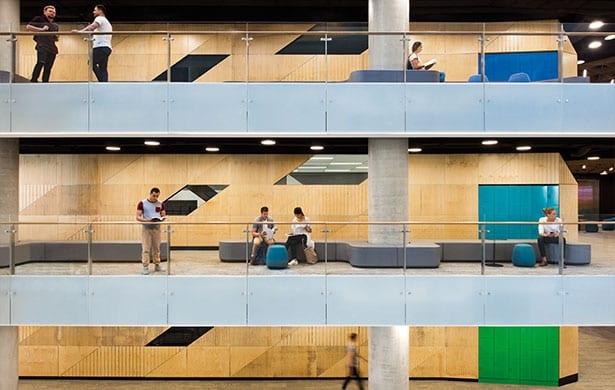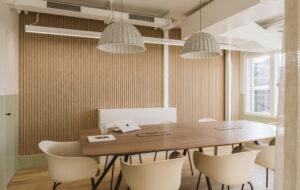 |||
|||
Future-focused is a term that’s been thrown around quite a lot recently. Epitomising flexibility and the ability to change to meet the ever-evolving demands of the environment, it defines the way in which many companies are opting to comply with an upgrade fit for the forthcoming.
Western Sydney University’s (WSU’s) Parramatta City Campus is a fine example of this shift. Located in the heart of the city’s Parramatta central business district, the campus merges education, business and the community into one package – a blend that has produced a diverse and student-centred domain.
Global architecture firm Woods Bagot has created a building that aims to suit every occasion, person and faculty – the architecture and its interior boasts a highly flexible frame which, throughout the construction, was a characteristic that filtered through all aspects of the build.
 Neutral, spare finishes can fit with a variety of uses
Neutral, spare finishes can fit with a variety of uses
“The building occupants changed throughout this process, giving rise to the term ‘course agnostic’, which meant we had to design a vertical learning campus that could cater for any faculty,” says Georgia Singleton, director at Woods Bagot.
This flexible approach is used to create “agile learning environments”. Alan J Duffy, Australian education sector leader at Woods Bagot, describes the result as “spaces that can accommodate multi-purpose functions and many different learning modes through flexible and adaptive design principles”. A no-barriers approach to design was sparked by a “non-faculty-specific brief” which allowed the team to “test the blend” between formal and informal learning spaces. “Our design outcome is a flexible and adaptive vertical campus environment encouraging learning through conversation,” explains Duffy.
With the aim of promoting and supporting collaboration between local businesses, industry and students, the new-build has blurred the boundaries of what’s traditionally assumed of an educational facility. “One of the particularly successful aspects of the design is the deliberate connection that was created between community and industry,” explains Singleton.
 Breakout spaces and lounges provide informal meeting space
Breakout spaces and lounges provide informal meeting space
WSU is a good example of a new academic approach to workspace where there aren’t any offices. Dedicated workstations, nearby meeting rooms, breakout spaces and staff lounges – these are a few factors that feature in the design, alongside quiet rooms in abundance, enabling academics to work in a “more focused environment” for as long as necessary.
Asked to imagine a university, most people think of a large building with several storeys, meeting rooms, a canteen and, most distinctively, lecture theatres. Strikingly, the WSU campus is theatre-free. “Pedagogy is changing,” says Singleton. “Lecture theatres represent a didactic method of teaching from master to apprentice, from teacher to student in a linear and instructional manner, where information is relayed one way from teacher to student.”
She adds: “With information so freely available online, there is no longer such a need for this method of learning. Instead of receiving instructional content in class – that is, a lecture – and completing assignment work for homework, some teachers facilitate instructional content online for students to engage with before class.”
 Freestanding furniture can be moved to create extra flexibility
Freestanding furniture can be moved to create extra flexibility
The desire for flexible design is increasing too, with multiple use of space often fundamental to the concept, breaking down the preconceptions of what it means to build an educational facility.
“The traditional metrics for education facilities are changing. Sharing of space is now more prevalent and flexible architecture is required in response,” says Duffy.
From “flipped classrooms” at the University of New South Wales School of Business in 2013, through to WSU’s “technology-enriched learning environments”, firms such as Woods Bagot are fully immersing their practice in future-forward design techniques. So what’s in store exactly? “Through the design of multi-purpose spaces, buildings can perform with adaptive purpose,” says Duffy. “Procurement of building assets, however, needs to change and adapt to accommodate this growing trend where space and use of space continue to flux.”
Woods Bagot’s Parramatta City Campus building in Sydney gives a whole new meaning to flexible learning
























